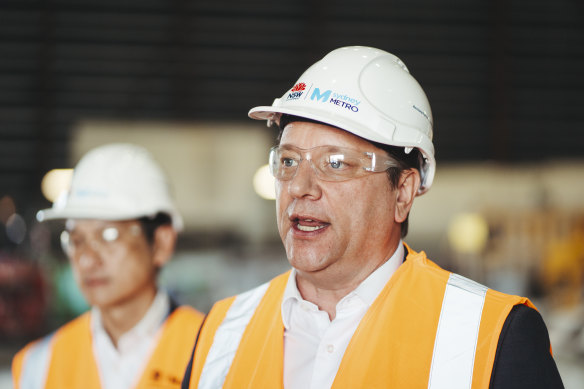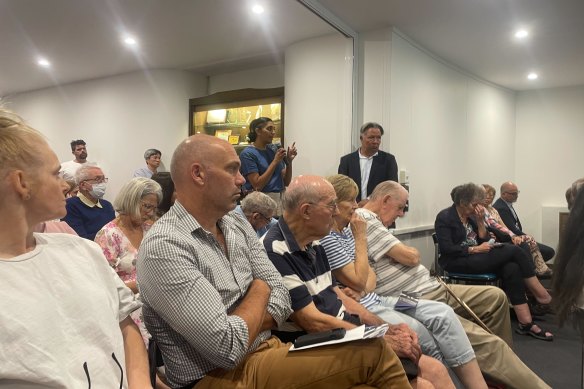This was published 1 year ago
Greater housing density is coming to a Sydney suburb near you. Here’s what you need to know
The state government has begun its transport-oriented development program. But what does it mean for your neighbourhood?

Roseville, one stop north of Chatswood, is among the transport-oriented development zones.Credit: Dion Georgopoulos
The news
The NSW government has formally commenced its Transport Oriented Development Program, a major prong in its plan to increase housing supply in NSW and help build 377,000 new homes by 2029.
From May 13, development applications can be lodged under the new policy at the first 18 train or metro stations. The new planning controls allow apartment blocks of up to six storeys (technically 22 metres, or 24 metres if there are shops on the ground floor) within 400 metres of the station.
It marks the start of a program that – at this stage – will expand to 37 train and metro stations by June 2025. There are also another eight “accelerated precincts”, mostly around current or future metro stations, that are being master-planned by the government for significantly more density.
Planning Minister Paul Scully said housing was “the largest single cost-of-living issue facing the people of NSW” and the plans finalised on Monday were a critical part of boosting vital supply.
How we got here
The government announced the TOD program in December, shortly after the Herald detailed the plans, which had been accidentally published on the Department of Planning website in advance.
It contained two tiers: the aforementioned “accelerated precincts”, where development would be greater, and a list of 31 stations where controls would be changed in April 2024, following a brief period of consultation with councils.
In early April, six more stations were added to the list, giving a total of 37. But many were also delayed to allow councils more time to put forward their own plans for deriving equal or greater housing growth.
For example, the starting date for Marrickville, Dulwich Hill and Ashfield was pushed back until December, while North Wollongong, St Marys and Wiley Park were delayed until April 2025.
On Monday, the government released detailed plans for the 18 starting sites and confirmed their start date as May 13. The program’s formal title is the Transport Oriented Development State Environmental Planning Policy (SEPP).
Key players
At a macro level, Premier Chris Minns has driven the government’s push for more housing density. He routinely cites Sydney’s prohibitively high cost of housing as a key reason people – especially young people of working age – are leaving the city.
Scully and his department secretary, Kiersten Fishburn, are responsible for the design of the TOD policy, with involvement from Transport Minister Jo Haylen (whose portfolio includes the Metro network, the basis for much of the forecast transport-oriented development), as well as Housing Minister Rose Jackson, whose key brief is social and affordable housing.

Planning Minister Paul Scully on Monday.Credit: Dion Georgopoulos
Heavily involved in this policy are local councils, with whom the state government has enjoyed a love-hate relationship. Minns put mayors on notice early in his term with barbs about NIMBY-ism. But recently, the government has been at pains to stress that councils are part of the solution. It offered councils significant deferrals on this TOD policy and promised the controls would only last until councils did their own planning, which yielded an equal or greater number of new homes.
The development industry is also a key player, helping to shape this and other government housing policies (on Monday, the Property Council described itself as “the original architects” of the policy). Generally, the industry has praised Minns for his ambition and rhetoric and cautiously welcomed each announcement, while warning publicly and privately that market conditions may render some of the solutions unfeasible.
What they said
Paul Scully, NSW planning minister: “This is a win-win-win for communities, where there is an opportunity for housing, an opportunity for jobs, an opportunity for greater amenity and close to public transport. These are the sorts of measures that will stop families packing up and giving up not only on Sydney but often on the rest of NSW.”
Mark Speakman, NSW opposition leader: “Premier Chris Minns called these the ‘largest planning reforms in the state’s history’, yet he failed to provide any opportunity for community consultation. While these areas are earmarked for more than 175,000 new homes, the Minns government hasn’t put one cent forward for new schools, roads or parks to support the increased population.”
Katie Stevenson, executive director, Property Council NSW: “Industry was adamant that the height controls under the TOD SEPP would need to double to make delivering the next wave of homes commercially viable. It is disappointing to see that these calls have fallen on deaf ears.”
What you need to know
As the TOD program moves from idea to plan to reality, the real question is now whether these reforms will actually lead to more housing - and how quickly. That’s why the feasibility of these potential developments is crucial.
The program has never pretended to be fast: the time frame is 15 years. That is because it takes a long time for developers to buy up property and amalgamate sites. Ultimately, it is up to property owners whether they want to sell. Once a suitable parcel of land has been acquired, the developer then has to lodge an application and go through the planning process, which can also be lengthy.
Land in Sydney is notoriously expensive, particularly in well-located areas such as the north shore and inner west. The development industry is now raising significant concerns that six storeys may not be enough to make a project viable. Put another way: the cost of land and construction will be such that the apartments won’t be affordable, if they are built at all.
Gavin Melvin, acting director of the Urban Development Institute of Australia (NSW), said the TOD program would need to be watched closely and improved “if it becomes clear it is not delivering as hoped”.
A political hot potato
The state Liberal opposition has sympathised with the government’s goal of boosting housing supply. That was ostensibly a goal of the previous administration, too: in 2017, then-planning minister Anthony Roberts was touting his own plan for transport-oriented development, saying: “This is a crisis. We’re almost at the point of no return.”
However, the Liberals are critical of Labor’s methods, accusing the government of trampling over local planning controls, failing to consult properly and neglecting new infrastructure for suburbs impacted by higher density.
The government points out that, by definition, the TOD locations are already served by a train or metro line. The Planning Department selected the 37 sites from a list of 305 because they already had the capacity to accommodate more homes, and recently published its full assessment criteria.

Up to 150 residents, councillors and stakeholders attended a meeting in Ku-ring-gai earlier in the year to voice concerns over the north shore TOD zones.Credit: Michael Koziol
Labor is also confident that younger voters want action on housing affordability and will reward any progress toward that end. Nonetheless, the issue will be politically divisive at the next election and during council elections to be held in September 2024.
The government is keen to stress that it is working with most councils toward a common aim - except Ku-ring-gai, on Sydney’s north shore, which resisted. New planning controls will commence at all four of its stations – Roseville, Lindfield, Killara and Gordon – on May 13.
That papers over tensions with quite a few councils, including Labor-led ones, such as Inner West. There, Labor is demanding the government do some of the hard yards itself by allocating billions to build social housing and releasing its long-awaited audit of public land suitable for housing development.
What’s next?
More TOD sites will roll out over the course of the year, in line with the government’s schedule. Numerous other prongs of its housing program are also due to be unveiled soon.
The first is a major reset of the state’s housing targets. This will detail where the 377,000 homes NSW is supposed to build under the National Housing Accord over the next five years will go.
We already know the flavour of this: higher numbers around infrastructure and transport, lower numbers on the city fringe. But seeing the targets in black-and-white (and the incentives to meet them) will give councils and constituents a clearer idea of the task ahead.
The government’s low– and mid-rise housing reforms will also kick in. These so-called “missing middle” changes are designed to encourage more granny flats, manor homes, and small apartment buildings. They will apply to many more areas. In Sydney, they are set to apply around all train, metro, and light rail stations, as well as any areas designated “town centres.”
Later in the year, the government is due to publish master plans for the eight accelerated precincts, including Crows Nest, Homebush, Bays West, Bella Vista and Macquarie Park. This will be a crucial indicator of what the government considers to be good planning around transport hubs. These sites alone are slated to generate up to 47,800 new homes over 15 years.
Start the day with a summary of the day’s most important and interesting stories, analysis and insights. Sign up for our Morning Edition newsletter.